供应链管理(英文课件)chapter8supply chain integration
合集下载
供应链管理教程ppt课件
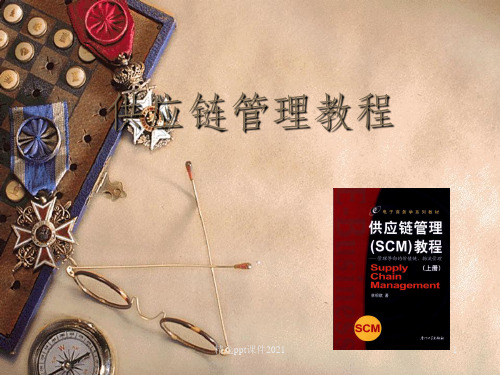
精选ppt课件2021
15
第一节信息技术基础
学完本节后,您将能够:
了解供应链管理系统中信息技术的基础构成; 了解信息技术的基本概念; 理解电子交易与供应链的关系; 了解EDI的优缺点,基于WEB上的EDI特点; 了解XML技术的应用; 理解应用软件的基本概念; 理解软件的基本架构;
理解应用软件典型特征。
制造业管理要素
Taxis
MRP
生产管理
生产执行
CAP
SFC
流程管理 数据管理 QMS
图4-12:制造管理要素
精选ppt课件2021
29
四、供应链管理下制造管理的特点
(一)企业经营规划的特点P226 (二)生产计划的特点P227 (三)生产管理的特点P228
以上数点反映了在整合的供应链下的制造管理已经不同 与传统的制造管理。关键的是采用了CBIS的应用系统, 才能形成这些的特点。
M5 Engineer to
order Discreet
销 分销
客
售 D1渠道
库 D2批发渠道
存
D3直销渠道 D4零售渠道
户 存 货 、
和 D5退货渠道
库
物 D6 Intermed.Mfg 存
流
Supply Channels D7 Field Service
Channels
和 物 流
精选ppt课件2021
MIS、DSS、KBS
EntIS或ERP
图2-1:供应链管理与企业信息系统的关系
精选ppt课件2021
8
二、企业内供应链信ຫໍສະໝຸດ 系统的逻辑结构(一)SCM中MIS基本结构模型
在图2-2中,表示了供应链管理中的MIS的基本结构模型,在这个模 型的数据库中,有来自AIS所提供的数据,更多的是由企业内供 应链流程作业的各种信息,还有来自IOIS的信息。数据库通过 报表系统将产生周期性的报表和特别的报表,另外,它还产生 一些数学模型,主要有记录、统计、查询、计算等等。
物流专业英语UnitSupplychainPPT课件
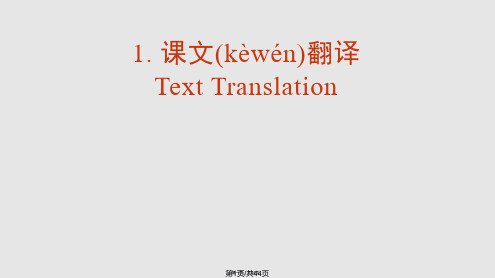
What is supply chain management? Supply chain management (SCM) is concerned with the
integration, coordination and control of the flow of material, information and finances in supply chains.
产品是指一个单位在业务过程中向市场供应的物品(wùpǐn)。在下 面的生产品供应链中,产品指的是最终落入消费者手中的物品 (wùpǐn)。(未完再续)
第第1十5五页页,/共共444页4。页
(Continued续)It may be a new car, a television set, a tin of beans, etc. Other possible products include new buildings, roads or transport services and there will be associated with each of these a supply chain that describes the process by which they are delivered to the buyer.
第第2二1十页一页/,共共444页4。页
1. Answer the following questions in English:
第第2二2十页二页/,共共444页4。页
1)What is the definition of a supply chain?
A supply chain is a complex logistics system in which raw materials are converted into finished products and then distributed to end users (consumers or companies)
供应链管理详细资料(英文版)(ppt 47页)

• Increased margins through:
• cost savings along the supply chain • overhead cost reduction • reducing complexity
• Capital efficiency improvements:
• minimising investment in plant & equipment and inventories
What do Supply Chain people in Unilever do?
• Roles in different parts of the organisation
– factories – regional supply chains – business groups – corporate centre
Path to Growth -- 6 primary strategic thrusts
What is our strategy for the Path to Growth?
áIncrease revenue growth by
using consumer insight to deliver superior consumer benefits
本人刘彦1980年出生2003年毕业于兰州师范高等专科学校化学教育而后于2005年参加工作在甘肃省武威市凉州区洪祥镇陈家沟学校就职
Path to Growth identifies what we will do to deliver on our promises to shareholders: Increase revenue growth to 5% per annum
• cost savings along the supply chain • overhead cost reduction • reducing complexity
• Capital efficiency improvements:
• minimising investment in plant & equipment and inventories
What do Supply Chain people in Unilever do?
• Roles in different parts of the organisation
– factories – regional supply chains – business groups – corporate centre
Path to Growth -- 6 primary strategic thrusts
What is our strategy for the Path to Growth?
áIncrease revenue growth by
using consumer insight to deliver superior consumer benefits
本人刘彦1980年出生2003年毕业于兰州师范高等专科学校化学教育而后于2005年参加工作在甘肃省武威市凉州区洪祥镇陈家沟学校就职
Path to Growth identifies what we will do to deliver on our promises to shareholders: Increase revenue growth to 5% per annum
供应链管理(英文课件)Chapter8-Supply Chain Integration
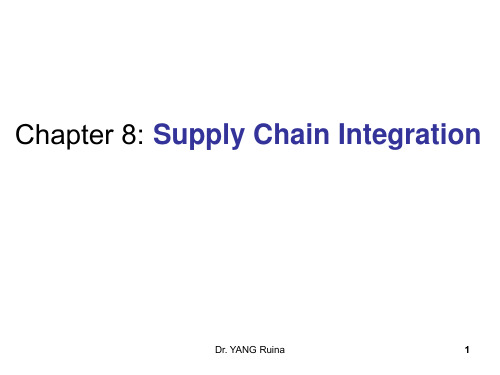
• better utilizing resources such as production and distribution capacities
• minimizing inventory, transportation, and production costs.
– Supply Chain Planning processes are applied.
costs – more emergency production changeovers
Pull-Based Supply Chains
• Production and distribution are demand driven
– Coordinated with true customer demand rather than forecast demand.
Push-Based Supply Chains
• Longer reaction time to changing marketplace:
– Inability to meet changing demand patterns. – Obsolescence of supply chain inventory as
• Advantages and disadvantages of push and pull supply chains:
– new supply chain strategy that takes the best of both. – Push–pull supply chain strategy
Impact of the Push-Pull Strategy
• Pull portion
– High uncertainty – Simple supply chain structure – Short cycle time – Focus on service level. – Achieved by deploying a flexible and
• minimizing inventory, transportation, and production costs.
– Supply Chain Planning processes are applied.
costs – more emergency production changeovers
Pull-Based Supply Chains
• Production and distribution are demand driven
– Coordinated with true customer demand rather than forecast demand.
Push-Based Supply Chains
• Longer reaction time to changing marketplace:
– Inability to meet changing demand patterns. – Obsolescence of supply chain inventory as
• Advantages and disadvantages of push and pull supply chains:
– new supply chain strategy that takes the best of both. – Push–pull supply chain strategy
Impact of the Push-Pull Strategy
• Pull portion
– High uncertainty – Simple supply chain structure – Short cycle time – Focus on service level. – Achieved by deploying a flexible and
《物流英语》课件 Unit 8 Supply Chain Management
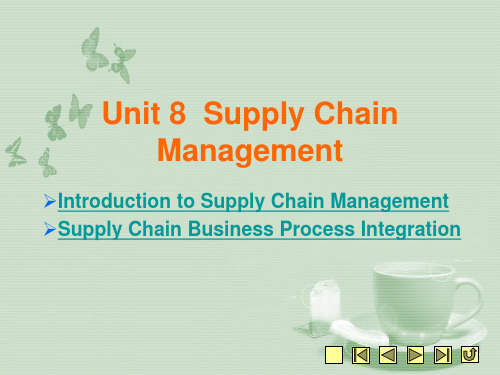
inventory, location and transportation among the participants in a supply chain to achieve the efficiency for the market being served.”
Therefore, supply chain management is the methodology to improve the business efficiency in finding raw components for your business product or service and delivering it to the customer.
Supply Chain Management
Supply chain management (SCM) means the design, planning and control of the information flow, movement of goods and money from the point of origin to the point of consumption with a view to
4. The companies in a supply chain will supply each other with raw materials, components , products and services.
5. The idea of supply chain management was first put forward in the 1980s on the basis of experience from the past practice.
Therefore, supply chain management is the methodology to improve the business efficiency in finding raw components for your business product or service and delivering it to the customer.
Supply Chain Management
Supply chain management (SCM) means the design, planning and control of the information flow, movement of goods and money from the point of origin to the point of consumption with a view to
4. The companies in a supply chain will supply each other with raw materials, components , products and services.
5. The idea of supply chain management was first put forward in the 1980s on the basis of experience from the past practice.
供应链管理英PPT

Copyright © 2001 by The McGraw-Hill Companies, Inc. All rights reserved.
McGraw-Hill/Irwin
Flow through the Supply Chain
Carrier Distribution center Supplier Carrier
1-1
JAMES R. STOCK
DOUGLAS M. LAMBERT
STRATEGIC LOGISTICS MANAGEMENT
FOURTH EDITION
McGraw-Hill/Irwin
Copyright © 2001 by The McGraw-Hill Companies, Inc. All rights reserved.
McGraw-Hill/Irwin
Lot quantity costs
Copyright © 2001 by The McGraw-Hill Companies, Inc. All rights reserved.
Relationship of Logistics Activities to Logistics Costs
Council of Logistics Management
McGraw-Hill/Irwin
Copyright © 2001 by The McGraw-Hill Companies, Inc. All rights reserved.
Components of Logistics Management
• • • • • • Customer service levels Transportation costs Warehousing costs Order processing/information systems costs Lot quantity costs Inventory carrying costs
McGraw-Hill/Irwin
Flow through the Supply Chain
Carrier Distribution center Supplier Carrier
1-1
JAMES R. STOCK
DOUGLAS M. LAMBERT
STRATEGIC LOGISTICS MANAGEMENT
FOURTH EDITION
McGraw-Hill/Irwin
Copyright © 2001 by The McGraw-Hill Companies, Inc. All rights reserved.
McGraw-Hill/Irwin
Lot quantity costs
Copyright © 2001 by The McGraw-Hill Companies, Inc. All rights reserved.
Relationship of Logistics Activities to Logistics Costs
Council of Logistics Management
McGraw-Hill/Irwin
Copyright © 2001 by The McGraw-Hill Companies, Inc. All rights reserved.
Components of Logistics Management
• • • • • • Customer service levels Transportation costs Warehousing costs Order processing/information systems costs Lot quantity costs Inventory carrying costs
物流管理学8_Integrating the supply chain
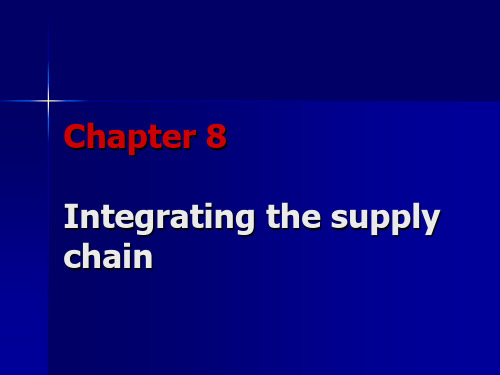
Wal-Mart “teaches” their suppliers how to minimize shipping, inventory and other costs by showing them their own model.
Content
Integration in the supply chain Efficient consumer response Collaborative planning, forecasting and replenishment Managing supply chain relationships
Financial Flow Decision Flow
Integration in the supply chain
Electronic collaboration
Transactional The electronic execution of
transaction
Information sharing The electronic sharing or exchange of information
Integration in the supply chain
Measures of integration
– Access to planning system – Sharing production plans – Joint EDI access / networks – Knowledge of inventory mix / levels – Packaging customization – Delivery frequencies – Common logistical equipment / containers – Common use of third-party logistics
Content
Integration in the supply chain Efficient consumer response Collaborative planning, forecasting and replenishment Managing supply chain relationships
Financial Flow Decision Flow
Integration in the supply chain
Electronic collaboration
Transactional The electronic execution of
transaction
Information sharing The electronic sharing or exchange of information
Integration in the supply chain
Measures of integration
– Access to planning system – Sharing production plans – Joint EDI access / networks – Knowledge of inventory mix / levels – Packaging customization – Delivery frequencies – Common logistical equipment / containers – Common use of third-party logistics
供应链管理课件英语国外原版

• Distributors: low inventory, reduced transportation costs, quick replenishment capability
• Customers: shorter order lead time, high in-stock inventory, large variety of products, low prices
• Strategic, tactical and operating issues
– Strategic - long term and dealing with supply chain design
• Determining the number, location and capacity of facilities • Make or buy decisions • Forming strategic alliances
Supply Chain Management - Introduction
In a supply chain, virtually all of the members serve as both customers as well as suppliers. In the Li & Fung example, the Korean yarn producer and the Japanese zipper producer are probably only suppliers and the customer’s customers (folks like you and me) are probably only customers. Every other organization in the supply chain is both a customer and a supplier. See the figure on slide five (green - supplier, yellow - customer, orange - both).
• Customers: shorter order lead time, high in-stock inventory, large variety of products, low prices
• Strategic, tactical and operating issues
– Strategic - long term and dealing with supply chain design
• Determining the number, location and capacity of facilities • Make or buy decisions • Forming strategic alliances
Supply Chain Management - Introduction
In a supply chain, virtually all of the members serve as both customers as well as suppliers. In the Li & Fung example, the Korean yarn producer and the Japanese zipper producer are probably only suppliers and the customer’s customers (folks like you and me) are probably only customers. Every other organization in the supply chain is both a customer and a supplier. See the figure on slide five (green - supplier, yellow - customer, orange - both).
Supply Chain Management—供应链管理PPT课件讲义教材
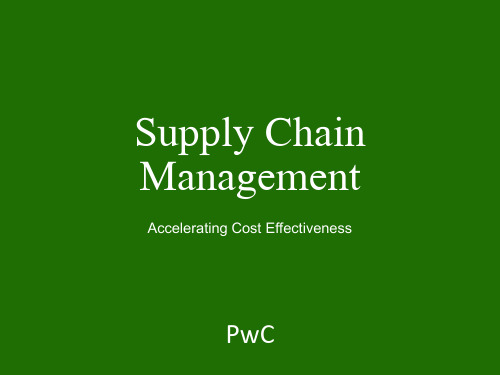
SCM Benefits
Materials Flows Information Flows
Cash Flows
Suppliers
Manufacturer
Distributors/ Wholesalers
Retailers
Customers
US companies expect to reap $3-400B of savings through a variety of benefits (3 – 5% of revenues)
• Today, the talk is of "supply networks", "parallel chains", "enhanced concurrent activities", and “customer centric” with new information platforms and technology set to cut both inventory and lead-times throughout the delivery pipeline further.
Retailers
Customer
Make what we sell, not sell what we make!
5
PricewaterhouseCoopers
Move to Cross-Functional Business Processes
Purchasing Manufacturing
Distribution
E-Business Support Management
Qualified Associates Integration
【全套精品课件】供应链管理英文课件
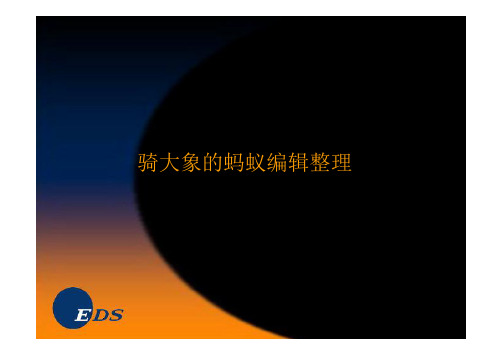
E
S
R
S
Capacity, Information, Core Competencies, Capital and Human Resources
Source: Supply Chain Faculty, Michigan State University
Challenges for Supply Chains
Aggregated buying power, auction-based buying/selling
• Achieve Process Simplification
Automated steps, One-step business
THE INTEGRATED SUPPLY CHAIN
Relationship Management
• Visibility
All partners have real time information about status and performance of each element in the supply chain from customers to suppliers.
• Optimization
• Take orders over the web, or automatically via B2B • Offer rich product selection and/or the ability to customize • Source the order and commit to delivery, immediately, online • Service the order online, including changes and inquiries • Deliver product quickly, efficiently, profitably • Be in constant communication with customers and suppliers
供应链管理英文课件-第章
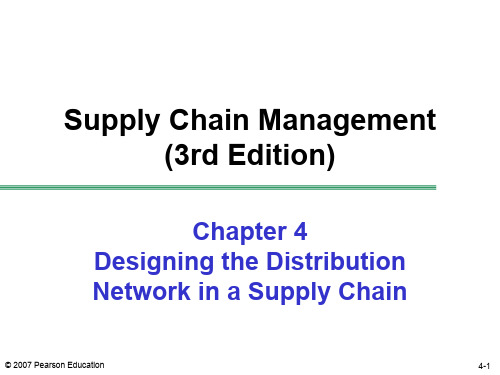
Supply Chain Management (3rd Edition)
Chapter 4 Designing the Distribution Network in a Supply Chain
© 2007 Pearson Education
4-1
Outline
The Role of Distribution in the Supply Chain Factors Influencing Distribution Network Design Design Options for a Distribution Network E-Business and the Distribution Network Distribution Networks in Practice Summary of Learning Objectives
© 2007 Pearson Education
4-2
The Role of Distribution in the Supply Chain
Distribution: the steps taken to move and store a product from the supplier stage to the customer stage in a supply chain
Number of facilities
4-9
Facility Costs and Number of Facilities (Fig. 4.4)
Facility Costs
Number of facilities
© 2007 Pearson Education
4-10
Total Costs Related to Number of Facilities
Chapter 4 Designing the Distribution Network in a Supply Chain
© 2007 Pearson Education
4-1
Outline
The Role of Distribution in the Supply Chain Factors Influencing Distribution Network Design Design Options for a Distribution Network E-Business and the Distribution Network Distribution Networks in Practice Summary of Learning Objectives
© 2007 Pearson Education
4-2
The Role of Distribution in the Supply Chain
Distribution: the steps taken to move and store a product from the supplier stage to the customer stage in a supply chain
Number of facilities
4-9
Facility Costs and Number of Facilities (Fig. 4.4)
Facility Costs
Number of facilities
© 2007 Pearson Education
4-10
Total Costs Related to Number of Facilities
- 1、下载文档前请自行甄别文档内容的完整性,平台不提供额外的编辑、内容补充、找答案等附加服务。
- 2、"仅部分预览"的文档,不可在线预览部分如存在完整性等问题,可反馈申请退款(可完整预览的文档不适用该条件!)。
- 3、如文档侵犯您的权益,请联系客服反馈,我们会尽快为您处理(人工客服工作时间:9:00-18:30)。
• Summary
2
Introduction
• Effective SCM implies:
– Efficient integration of suppliers, manufacturers, warehouses, and stores.
– Coordinate activities across the supply chain.
• Various supply chain integration strategies:
– Push, pull, push–pull strategy. – Matching products and industries with supply
chain strategies. – Demand-driven supply chain strategies. – The impact of the Internet on supply chain
Bullwhip Effect in Push-Based Supply Chains
• Leads to inefficient resource utilization • Planning and managing are much more difficult. • Not clear how a manufacturer should determine
production capacity? Transportation capacity?
– Peak demand? – Average demand?
• Results:
– Higher transportation costs – Higher inventory levels and/or higher manufacturing
Push-Based Supply Chains
• Longer reaction time to changing marketplace:
– Inability to meet changing demand patterns. – Obsolescence of supply chain inventory as
Introduction
• Challenges can be met by integrating:
– the front-end, customer demand, – to the back-end, production and manufacturing
portion of the supply chain.
– Reduced inventory since inventory levels increase with lead times.
– Less variability in the system. – Decreased inventory at the manufacturer due
to the reduction in variability.
Chapter 8: Supply Chain Integration
Dr. YANG Ruina
1
Agenda
• Introduction
• Push, Pull, and Push-Pull Systems
• Choosing the Appropriate Supply Chain Strategy
Push-Based Supply Chains
• Production and distribution decisions based on long-term forecasts.
• Manufacturer demand forecasts based on orders received from the retailer’s wa, Push-Pull Systems
• Traditional supply chain strategies are categorized as Push and Pull strategies.
• More recent hybrid strategy of combining the two, Push-Pull systems
demand for certain products disappears. – Variability of orders received much larger than
the variability in customer demand due to the bullwhip effect.
• Improve performance: reduce cost, increase service level, reduce the bullwhip effect, better utilize resources, and effectively respond to changes in the market place.
– firm does not hold any inventory and only responds to specific orders.
Pull-Based Supply Chains
• Intuitively attractive:
– Reduced lead times through the ability to better anticipate incoming orders from the retailers.
costs – more emergency production changeovers
Pull-Based Supply Chains
• Production and distribution are demand driven
– Coordinated with true customer demand rather than forecast demand.
2
Introduction
• Effective SCM implies:
– Efficient integration of suppliers, manufacturers, warehouses, and stores.
– Coordinate activities across the supply chain.
• Various supply chain integration strategies:
– Push, pull, push–pull strategy. – Matching products and industries with supply
chain strategies. – Demand-driven supply chain strategies. – The impact of the Internet on supply chain
Bullwhip Effect in Push-Based Supply Chains
• Leads to inefficient resource utilization • Planning and managing are much more difficult. • Not clear how a manufacturer should determine
production capacity? Transportation capacity?
– Peak demand? – Average demand?
• Results:
– Higher transportation costs – Higher inventory levels and/or higher manufacturing
Push-Based Supply Chains
• Longer reaction time to changing marketplace:
– Inability to meet changing demand patterns. – Obsolescence of supply chain inventory as
Introduction
• Challenges can be met by integrating:
– the front-end, customer demand, – to the back-end, production and manufacturing
portion of the supply chain.
– Reduced inventory since inventory levels increase with lead times.
– Less variability in the system. – Decreased inventory at the manufacturer due
to the reduction in variability.
Chapter 8: Supply Chain Integration
Dr. YANG Ruina
1
Agenda
• Introduction
• Push, Pull, and Push-Pull Systems
• Choosing the Appropriate Supply Chain Strategy
Push-Based Supply Chains
• Production and distribution decisions based on long-term forecasts.
• Manufacturer demand forecasts based on orders received from the retailer’s wa, Push-Pull Systems
• Traditional supply chain strategies are categorized as Push and Pull strategies.
• More recent hybrid strategy of combining the two, Push-Pull systems
demand for certain products disappears. – Variability of orders received much larger than
the variability in customer demand due to the bullwhip effect.
• Improve performance: reduce cost, increase service level, reduce the bullwhip effect, better utilize resources, and effectively respond to changes in the market place.
– firm does not hold any inventory and only responds to specific orders.
Pull-Based Supply Chains
• Intuitively attractive:
– Reduced lead times through the ability to better anticipate incoming orders from the retailers.
costs – more emergency production changeovers
Pull-Based Supply Chains
• Production and distribution are demand driven
– Coordinated with true customer demand rather than forecast demand.
